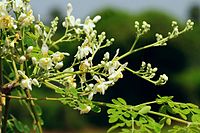
Photo from wikipedia
Abstract Despite the critical importance of complementary feeding, large proportions of children in developing countries are sub-optimally fed during 6–23 months of age. In Ethiopia, even though the government has… Click to show full abstract
Abstract Despite the critical importance of complementary feeding, large proportions of children in developing countries are sub-optimally fed during 6–23 months of age. In Ethiopia, even though the government has been rolling out infant and young child feeding (IYCF) guidelines, the proportion of mothers adhering to the recommended optimal practices and its associated factors have not been assessed in different agro-ecological areas. Hence, the present study aimed to determine optimal complementary feeding practices and associated factors in three agro-ecological rural districts (high, mid and lowland) of southwest Ethiopia. A community-based cross-sectional study was carried out among 845 mothers-index young children 6–23 months Jimma zone. Multistage sampling was employed to select the study participants. Structured and pretested questionnaires were used to collect data and entered into Epi Data V.1.4.4.0. The data were analysed using SPSS version 20. Binary and multivariable logistic regressions were used to identify factors associated with optimal child-feeding practices. The significance of the association was determined at P < 0⋅05. The overall proportion of optimal complementary feeding practice (OCFP) was 9⋅4 % at 95 % CI (7⋅19, 11⋅08). The timely initiation of complementary feeding, minimum meal frequency, minimum dietary diversity and minimum acceptable diet was 52⋅2, 64⋅1, 17⋅2 and 12⋅2 %. Multivariable logistic regression showed that being in the highland districts, having good maternal knowledge, and mothers having primary school education, having a family size of less than six were positively associated with optimal complementary feeding practices. The findings showed that OCFP was low, especially in the midland agro-ecological districts.
Journal Title: Journal of Nutritional Science
Year Published: 2023
Link to full text (if available)
Share on Social Media: Sign Up to like & get
recommendations!